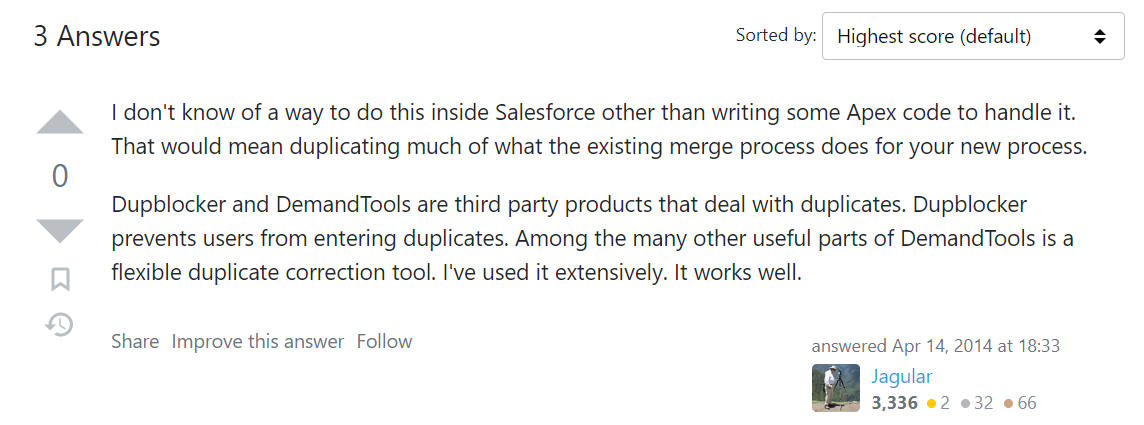Salesforce is the go-to solution for many businesses to organize and manage their customer data, but it’s hard to keep things organized without merging accounts in Salesforce. Inconsistencies such as duplicate records and outdated data can complicate things, especially when managing large amounts of customer information.
Let’s say a business has two accounts for the same customer—one having accurate information about the customer’s purchase history and the other one having inaccurate information. You may end up sending promotional offers to the wrong audience or sending the same information twice.
This leads to poor business decisions and wasted resources. And above all, it makes you look bad! The good thing is that Salesforce helps you eliminate redundant data and merge those duplicate accounts. And today, we’ll discuss how to merge accounts in Salesforce under different scenarios.
Table of Contents
ToggleWhen Should You Merge Accounts on Salesforce?
There are several instances when you may need to merge accounts in Salesforce. Here are some common scenarios:
- Over time, a Salesforce database may accumulate outdated or redundant accounts. Merging these accounts can help to keep your data clean and accurate. Moreover, it helps eliminate confusion and ensures all team members have access to the same information.
- When a user leaves your company or changes roles, you can merge their accounts with another user’s to maintain that data in your records.
- You can reorganize and streamline data for ease of access in case two departments in your company merge. You’ll need to merge the corresponding accounts for each department to reflect the change and ensure all your data is in one place.
- If your business acquires another company that uses Salesforce, you may need to merge the accounts to consolidate the data.
It’s important to note that you should merge accounts with caution, as it can have implications on related records and data. One tiny mishap can cost you a fortune and cause a huge setback for your business.
How to Merge Accounts in Salesforce Classic vs. Lightning
Salesforce offers two kinds of interfaces: Classic and Lightning. And the merging process differs for each interface.
But first, let’s understand how the two interfaces differ:
- Regarding look and feel, the Classic version seems more traditional and familiar. The lightning version has a more modern and sleek appearance.
- The Classic version has a top navigation bar, while the Lightning version has it on the left-hand side.
- The Lightning version has more customization features than the Classic. You can drag and drop components to create custom pages and dashboards.
- Lightning is fully optimized for mobile use, whereas Classic has limited support for mobile.
- Lightning has better integration capabilities than the Classic version.
The Classic version is more familiar to the OG Salesforce users, as it pretty much remains the same as before. However, many businesses or first-time users that want to avail the latest Salesforce features and functionalities opt for Lightning. The choice really depends on your requirements and ease of use.
How to Merge Accounts in Salesforce
Case 1: Enable the Merge Accounts Feature in Salesforce
If you’re not using an admin account but a personal account, you need to ensure that the “Merge Accounts” feature is enabled in your Salesforce. Just send a request to the Salesforce admin, and they’ll enable it for you.
But, if you’re the Salesforce admin who has received a request to enable merge accounts, here are the steps to follow:
- Click on Settings -> Service Setup
- Click on “Permission Sets,” where you can edit permissions or create a new one.
- Select “License,” if applicable, and click “Save.”
- Navigate to Object Settings -> Duplicate Record Sets.
- Click on “Edit,” edit the object’s permissions and click “Save.”
- Go to “Users” and search for the user.
- Click on Permission Set Assignments -> Edit Assignments.
- Select the permission name and click “Save.”
Case 2: Merging Duplicate Accounts
Let’s discuss the merging process for Classic and Lightning one by one.
Merge Accounts in Salesforce Classic
- Go to accounts -> Tools.
- Click on Merge accounts.
- Enter the search string to find duplicate accounts.
- Select up to three accounts that you want to merge and click “Next.”
- Select one master record and the fields that you wish to retain from each record.
- Click “Merge,” and it’s done!
Merge Accounts in Salesforce Lightning
With Lightning, you can simply look for duplicates for a specific account by clicking on “View Duplicates.” However, with this approach, you can only merge accounts having the exact same names. If you need to merge duplicate accounts you can’t find on the Lightning dashboard, switch to Classic and use the Merge Accounts tool.
Case 3: Merging Non-Duplicate Accounts
Often, you need to merge an account into another due to a name change or a business overtake. Though there’s no direct way of merging accounts that don’t have the same names, there’s a workaround.
- Go to “Account” and search for the old account you want to merge.
- Click “Edit” and omit its name with the name of the new account you’re merging it with (you’ll know why we’re doing this in a bit).
- And Save.
- Go to the “Merge Account” Tool and enter the string you omitted the old account with (You’ll now have 2 duplicate accounts on the screen).
- Repeat the steps to merge duplicate accounts in Salesforce Classic.
Case 4: Mass Merge in Salesforce
Currently, Salesforce only allows up to merge up to 3 accounts. And if you have a massive list of duplicate accounts you want to merge, it can take hours (if not days) to get it done.
Thankfully, there are third-party apps that offer mass merge functionality to merge multiple accounts at once.
Here are some recommendations:
- ZaapIT: Using ZaapIt, you can create merge rules or jobs and create the merge strategy you like. Review the search results and select the records that you want to merge.
- DupeCatcher: DupeCatcher has pre-built filters to help you quickly eliminate your duplicates. You can create multiple rules and filters to trigger an alert or run a mass merge.
- DemandTools: DemandTools offers a suite of data management tools, including mass merge functionality. It has pre-configured matching rules to help you get started quickly, and you can even schedule your merges.
Case 5: Automating The Merging of Duplicate Accounts
For the developer folks, it might be easy to automate this task by writing an apex code to create a trigger:
Source
You could create a trigger that detects when a new account is created or updated. It can then automatically initiate a merge process upon detecting any duplicate accounts. However, if you want to avoid all this trouble, you can simply opt for tools that could do it for you. Some tools mentioned above, like DemandTools, are a great option.
How to Ensure Your Data Is Up-to-Date on Salesforce
While merging accounts is a good way to get rid of duplicates in your database, it’s possible to avoid it in the first place. This way, you’ll have more time for other important tasks and a streamlined data of customer accounts. For this, you need to keep Salesforce data hygiene in check to maintain your data quality:
- Create data validation rules that check if the data you entered meets specific criteria. This will prevent you or other users from entering incomplete or inaccurate data into the record.
- Schedule regular data hygiene tasks such as merging duplicates, standardizing data formats, and removing outdated records.
- Use data integration tools to automatically update data from external sources such as your website, marketing automation software, or customer support system. For example, with Match My Email, you can sync your Calendar and Email Data to Salesforce and permanently store them.
- Train your Salesforce users on the importance of maintaining accurate and up-to-date data. Make sure they know how to enter and manage data within Salesforce properly. Use your Salesforce knowledge base internally to clarify the best practices.
- Regularly review reports and dashboards in your Salesforce org to keep data quality in check. It helps identify any issues in the database, such as incomplete or inaccurate data, data discrepancies, or inconsistencies.
Eliminate Inconsistencies In Your Data
Maintaining accurate and up-to-date data in Salesforce is crucial for a business. And merging accounts is a big part of that process. Not only do you save time and resources by merging all the inaccurate and duplicate data from the record, but you also make your workflow more productive. More importantly, you keep your marketing and sales in perfect alignment to provide personalized content to each user.
While Salesforce helps you merge your duplicate data in both the Classic and Lightning interfaces, there are also some third-party tools offering more advanced features. If you have many accounts that you need to merge, go for paid tools with more customization capabilities.
Choose a merging method that meets your business needs and keep your database up to date!







